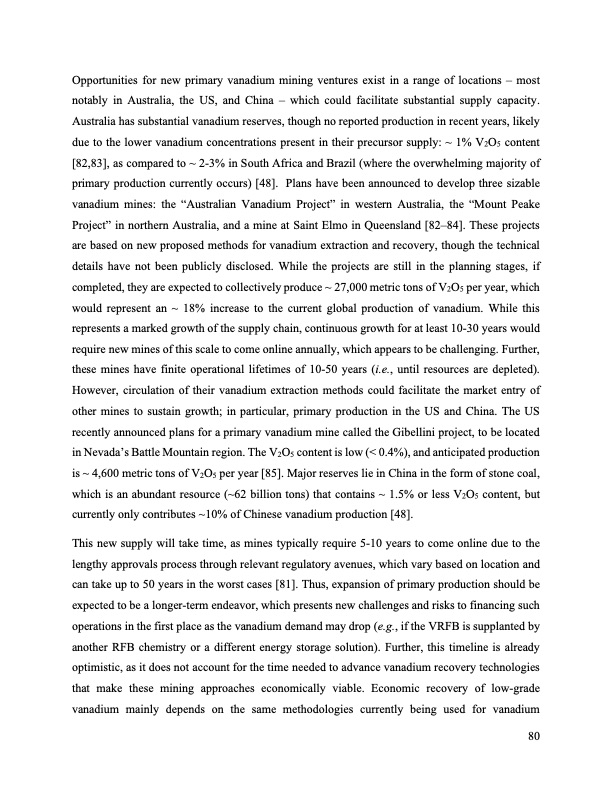
PDF Publication Title:
Text from PDF Page: 080
Opportunities for new primary vanadium mining ventures exist in a range of locations – most notably in Australia, the US, and China – which could facilitate substantial supply capacity. Australia has substantial vanadium reserves, though no reported production in recent years, likely due to the lower vanadium concentrations present in their precursor supply: ~ 1% V2O5 content [82,83], as compared to ~ 2-3% in South Africa and Brazil (where the overwhelming majority of primary production currently occurs) [48]. Plans have been announced to develop three sizable vanadium mines: the “Australian Vanadium Project” in western Australia, the “Mount Peake Project” in northern Australia, and a mine at Saint Elmo in Queensland [82–84]. These projects are based on new proposed methods for vanadium extraction and recovery, though the technical details have not been publicly disclosed. While the projects are still in the planning stages, if completed, they are expected to collectively produce ~ 27,000 metric tons of V2O5 per year, which would represent an ~ 18% increase to the current global production of vanadium. While this represents a marked growth of the supply chain, continuous growth for at least 10-30 years would require new mines of this scale to come online annually, which appears to be challenging. Further, these mines have finite operational lifetimes of 10-50 years (i.e., until resources are depleted). However, circulation of their vanadium extraction methods could facilitate the market entry of other mines to sustain growth; in particular, primary production in the US and China. The US recently announced plans for a primary vanadium mine called the Gibellini project, to be located in Nevada’s Battle Mountain region. The V2O5 content is low (< 0.4%), and anticipated production is ~ 4,600 metric tons of V2O5 per year [85]. Major reserves lie in China in the form of stone coal, which is an abundant resource (~62 billion tons) that contains ~ 1.5% or less V2O5 content, but currently only contributes ~10% of Chinese vanadium production [48]. This new supply will take time, as mines typically require 5-10 years to come online due to the lengthy approvals process through relevant regulatory avenues, which vary based on location and can take up to 50 years in the worst cases [81]. Thus, expansion of primary production should be expected to be a longer-term endeavor, which presents new challenges and risks to financing such operations in the first place as the vanadium demand may drop (e.g., if the VRFB is supplanted by another RFB chemistry or a different energy storage solution). Further, this timeline is already optimistic, as it does not account for the time needed to advance vanadium recovery technologies that make these mining approaches economically viable. Economic recovery of low-grade vanadium mainly depends on the same methodologies currently being used for vanadium 80PDF Image | Bringing Redox Flow Batteries to the Grid

PDF Search Title:
Bringing Redox Flow Batteries to the GridOriginal File Name Searched:
Rodby-krodby-phd-chemE-2022-thesis.pdfDIY PDF Search: Google It | Yahoo | Bing
Salgenx Redox Flow Battery Technology: Salt water flow battery technology with low cost and great energy density that can be used for power storage and thermal storage. Let us de-risk your production using our license. Our aqueous flow battery is less cost than Tesla Megapack and available faster. Redox flow battery. No membrane needed like with Vanadium, or Bromine. Salgenx flow battery
| CONTACT TEL: 608-238-6001 Email: greg@salgenx.com | RSS | AMP |